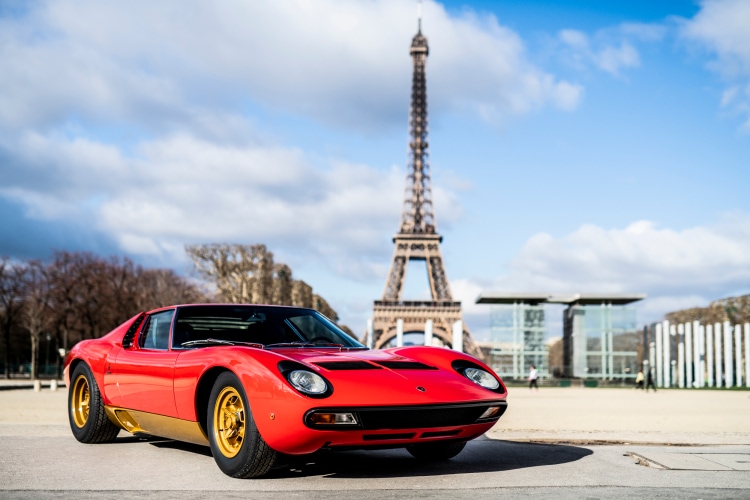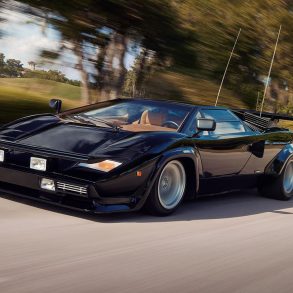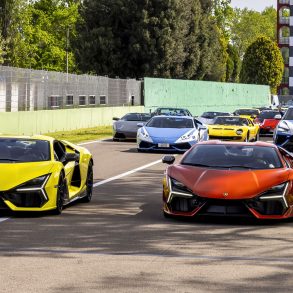In March 1971, the Lamborghini Miura SV, being the last evolution of the highly successful P400 project, made its official debut at the Geneva Motor Show’s Lamborghini stand. In the same event, Carrozzeria Bertone additionally unveiled their concept car for future production: the Countach LP 500.
It was initially expected that the Miura SV would accompany the S version, but after the enormous success that it enjoyed, the SV replaced the S version.

The Miura SV is the most coveted production vehicle ever to be produced by Lamborghini, considered by many to be the best representation of the ‘supercar’ concept of its time.
The creators of the Miura and Miura S, Giampaolo Dallara and Paolo Stanzani have affirmed that the SV profited from all the experience and lessons they discovered in the first five years of the Miura production.

The engine of the SV delivered increased power, producing 385 HP at 7850 rpm. Handling was also improved due to its improved torque (40.7kgm at 5750 rpm) with the four type 40IDL3C Weber triple barrel carburetors also receiving a new setting.
A hugely significant technical improvement, implemented while the SV was already in production, was introducing a separate lubrication system between the engine and gearbox.

Compared to the other Miuras, the P 400 and P400 S, the Miura SV sets itself apart technically and stylistically.
While preserving the general layout with a 4-liter 12-cylinder transversely mounted rear-mid engine, the SV was supplied with a stiffer chassis with some strategic reinforcements. The SV had an almost 130mm wide track and a revised rear suspension system with different anchor points and arms.

The tires of the front and rear of the Miura SV are different sizes, with the rear wheels increased from 7 to 9 inches and equipped with 255-section tires. Even the rims’ design was improved to deliver a sportier look, with many SV customers ordering the rims with the striking gold finish.
The Miura SV’s technical modifications also meant an update on the exterior was needed, handing the responsibility to the very person who oversaw the original project: Marcello Gandini. The updated SV displayed wider rear fenders, a front bonnet characterized by a new air intake for the radiator, and newly designed taillights.


One of the most significant visual changes on the Miura SV is the absence of the famous “eyelashes” around the headlights.
Technically, there was no real reason as to why Lamborghini made the aesthetic modification except that Ferruccio Lamborghini knew that the assembly and perfect finishing of the eyelashes was not just complex but time-consuming. He aimed to reduce the production time of the Miura. However, for his own personal Miura SV, he requested that the eyelashes around the headlights be kept- the only one to officially have this specification.

When looking at the Miura SV interior, it adopts a more modern look with a better finish when compared to its predecessors. This is principally due to the use of more leather on the upholstery and various chromed details.
The official top speed of the Miura SV is more than 290 kph, and from a standing start, it was able to complete a kilometer in just below 24 seconds – a record performance at the time.
In early 1973, after producing 150 units, the Miura SV was taken out of production. Two years later, in 1975, a final unit was explicitly manufactured for Walter Wolf. The vehicle is now at MUDETEC, Lamborghini Museum in Sant’Agata Bolognese.

The discontinuance of the production of the Miura SV ended the era where speed and sinuous lines dominated. The Miura SV was the embodiment of what a group of young men, driven by their passion and excellent technical skills, created what many consider to be the most beautiful car ever produced in series.
[Source: Lamborghini]











I’ve always loved the shape of the Miura since being a kid…..but it surprised me to read somewhere that the shape was inspired by the Ford GT40…another car of the era that I loved. But I never connected the two….sure enough, if you look closely, one can see the resemblance.